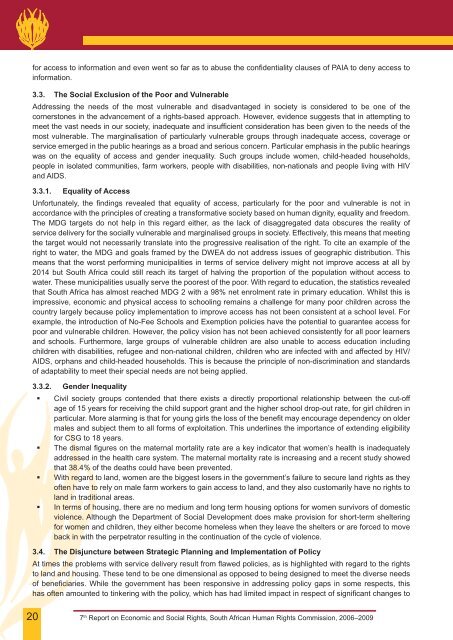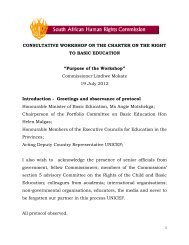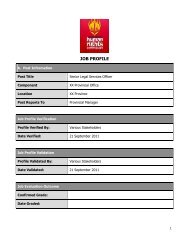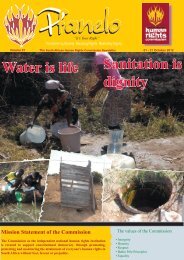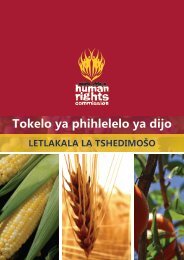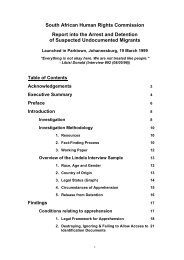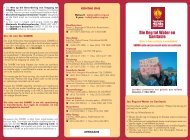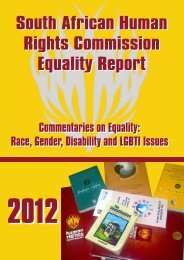Chapter 1 - South African Human Rights Commission
Chapter 1 - South African Human Rights Commission
Chapter 1 - South African Human Rights Commission
- No tags were found...
Create successful ePaper yourself
Turn your PDF publications into a flip-book with our unique Google optimized e-Paper software.
for access to information and even went so far as to abuse the con dentiality clauses of PAIA to deny access to<br />
information.<br />
3.3. The Social Exclusion of the Poor and Vulnerable<br />
Addressing the needs of the most vulnerable and disadvantaged in society is considered to be one of the<br />
cornerstones in the advancement of a rights-based approach. However, evidence suggests that in attempting to<br />
meet the vast needs in our society, inadequate and insufcient consideration has been given to the needs of the<br />
most vulnerable. The marginalisation of particularly vulnerable groups through inadequate access, coverage or<br />
service emerged in the public hearings as a broad and serious concern. Particular emphasis in the public hearings<br />
was on the equality of access and gender inequality. Such groups include women, child-headed households,<br />
people in isolated communities, farm workers, people with disabilities, non-nationals and people living with HIV<br />
and AIDS.<br />
3.3.1. Equality of Access<br />
Unfortunately, the ndings revealed that equality of access, particularly for the poor and vulnerable is not in<br />
accordance with the principles of creating a transformative society based on human dignity, equality and freedom.<br />
The MDG targets do not help in this regard either, as the lack of disaggregated data obscures the reality of<br />
service delivery for the socially vulnerable and marginalised groups in society. Effectively, this means that meeting<br />
the target would not necessarily translate into the progressive realisation of the right. To cite an example of the<br />
right to water, the MDG and goals framed by the DWEA do not address issues of geographic distribution. This<br />
means that the worst performing municipalities in terms of service delivery might not improve access at all by<br />
2014 but <strong>South</strong> Africa could still reach its target of halving the proportion of the population without access to<br />
water. These municipalities usually serve the poorest of the poor. With regard to education, the statistics revealed<br />
that <strong>South</strong> Africa has almost reached MDG 2 with a 98% net enrolment rate in primary education. Whilst this is<br />
impressive, economic and physical access to schooling remains a challenge for many poor children across the<br />
country largely because policy implementation to improve access has not been consistent at a school level. For<br />
example, the introduction of No-Fee Schools and Exemption policies have the potential to guarantee access for<br />
poor and vulnerable children. However, the policy vision has not been achieved consistently for all poor learners<br />
and schools. Furthermore, large groups of vulnerable children are also unable to access education including<br />
children with disabilities, refugee and non-national children, children who are infected with and affected by HIV/<br />
AIDS, orphans and child-headed households. This is because the principle of non-discrimination and standards<br />
of adaptability to meet their special needs are not being applied.<br />
3.3.2. Gender Inequality<br />
• Civil society groups contended that there exists a directly proportional relationship between the cut-off<br />
age of 15 years for receiving the child support grant and the higher school drop-out rate, for girl children in<br />
particular. More alarming is that for young girls the loss of the bene t may encourage dependency on older<br />
males and subject them to all forms of exploitation. This underlines the importance of extending eligibility<br />
for CSG to 18 years.<br />
• The dismal gures on the maternal mortality rate are a key indicator that women’s health is inadequately<br />
addressed in the health care system. The maternal mortality rate is increasing and a recent study showed<br />
that 38.4% of the deaths could have been prevented.<br />
• With regard to land, women are the biggest losers in the government’s failure to secure land rights as they<br />
often have to rely on male farm workers to gain access to land, and they also customarily have no rights to<br />
land in traditional areas.<br />
• In terms of housing, there are no medium and long term housing options for women survivors of domestic<br />
violence. Although the Department of Social Development does make provision for short-term sheltering<br />
for women and children, they either become homeless when they leave the shelters or are forced to move<br />
back in with the perpetrator resulting in the continuation of the cycle of violence.<br />
3.4. The Disjuncture between Strategic Planning and Implementation of Policy<br />
At times the problems with service delivery result from awed policies, as is highlighted with regard to the rights<br />
to land and housing. These tend to be one dimensional as opposed to being designed to meet the diverse needs<br />
of bene ciaries. While the government has been responsive in addressing policy gaps in some respects, this<br />
has often amounted to tinkering with the policy, which has had limited impact in respect of signi cant changes to<br />
20<br />
7 th Report on Economic and Social <strong>Rights</strong>, <strong>South</strong> <strong>African</strong> <strong>Human</strong> <strong>Rights</strong> <strong>Commission</strong>, 2006–2009


